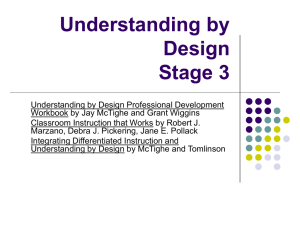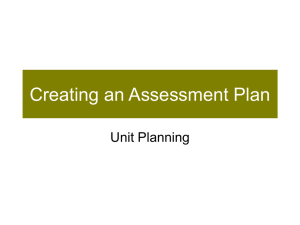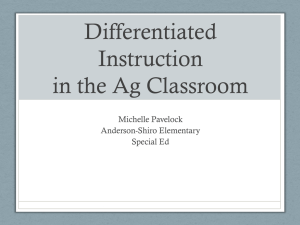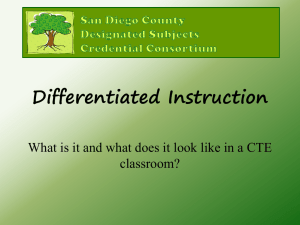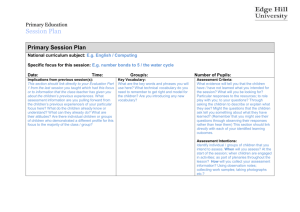File
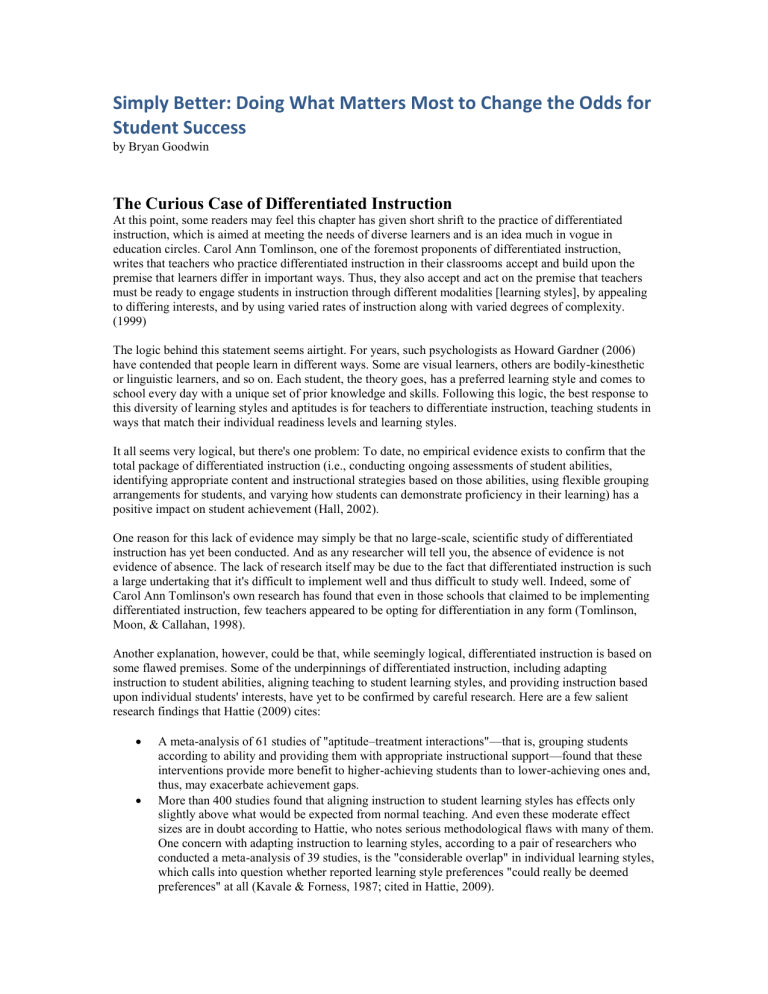
Simply Better: Doing What Matters Most to Change the Odds for
Student Success
by Bryan Goodwin
The Curious Case of Differentiated Instruction
At this point, some readers may feel this chapter has given short shrift to the practice of differentiated instruction, which is aimed at meeting the needs of diverse learners and is an idea much in vogue in education circles. Carol Ann Tomlinson, one of the foremost proponents of differentiated instruction, writes that teachers who practice differentiated instruction in their classrooms accept and build upon the premise that learners differ in important ways. Thus, they also accept and act on the premise that teachers must be ready to engage students in instruction through different modalities [learning styles], by appealing to differing interests, and by using varied rates of instruction along with varied degrees of complexity.
(1999)
The logic behind this statement seems airtight. For years, such psychologists as Howard Gardner (2006) have contended that people learn in different ways. Some are visual learners, others are bodily-kinesthetic or linguistic learners, and so on. Each student, the theory goes, has a preferred learning style and comes to school every day with a unique set of prior knowledge and skills. Following this logic, the best response to this diversity of learning styles and aptitudes is for teachers to differentiate instruction, teaching students in ways that match their individual readiness levels and learning styles.
It all seems very logical, but there's one problem: To date, no empirical evidence exists to confirm that the total package of differentiated instruction (i.e., conducting ongoing assessments of student abilities, identifying appropriate content and instructional strategies based on those abilities, using flexible grouping arrangements for students, and varying how students can demonstrate proficiency in their learning) has a positive impact on student achievement (Hall, 2002).
One reason for this lack of evidence may simply be that no large-scale, scientific study of differentiated instruction has yet been conducted. And as any researcher will tell you, the absence of evidence is not evidence of absence. The lack of research itself may be due to the fact that differentiated instruction is such a large undertaking that it's difficult to implement well and thus difficult to study well. Indeed, some of
Carol Ann Tomlinson's own research has found that even in those schools that claimed to be implementing differentiated instruction, few teachers appeared to be opting for differentiation in any form (Tomlinson,
Moon, & Callahan, 1998).
Another explanation, however, could be that, while seemingly logical, differentiated instruction is based on some flawed premises. Some of the underpinnings of differentiated instruction, including adapting instruction to student abilities, aligning teaching to student learning styles, and providing instruction based upon individual students' interests, have yet to be confirmed by careful research. Here are a few salient research findings that Hattie (2009) cites:
A meta-analysis of 61 studies of "aptitude–treatment interactions"—that is, grouping students according to ability and providing them with appropriate instructional support—found that these interventions provide more benefit to higher-achieving students than to lower-achieving ones and, thus, may exacerbate achievement gaps.
More than 400 studies found that aligning instruction to student learning styles has effects only slightly above what would be expected from normal teaching. And even these moderate effect sizes are in doubt according to Hattie, who notes serious methodological flaws with many of them.
One concern with adapting instruction to learning styles, according to a pair of researchers who conducted a meta-analysis of 39 studies, is the "considerable overlap" in individual learning styles, which calls into question whether reported learning style preferences "could really be deemed preferences" at all (Kavale & Forness, 1987; cited in Hattie, 2009).
Six hundred studies of individualized instruction (i.e., instruction based on students' individual interests and past learning experiences) found these efforts to be "only slightly better than regular classroom instruction" (Hattie, 2009).
The Trouble with Multiple Intelligences and Learning Styles
In his book Why Don't Students Like School?
, cognitive psychologist Daniel Willingham observes that
"children are more alike than different in terms of how they think and learn," adding that, "as far as scientists have been able to determine, there are not categorically different types of learners" (Willingham,
2009). He cautions, for example, against assuming that just because a student is naturally gifted in music he should be taught commas by being asked to write a song about them or that a child with bodily-kinesthetic aptitude should be asked to contort herself into the shape of a comma.
Willingham notes that Howard Gardner himself, the father of multiple intelligences theory, "disavows this idea, and he's right to do so". The problem with this line of thinking is that these different abilities— whether it's musical talent or being physically coordinated—have nothing to do with learning about commas. Similarly, "mathematical concepts have to be learned mathematically and skill in music won't help," writes Willingham. So too, one might add, a baseball coach is unlikely to help a child with a weak arm (but who is good at math) make a better throw from third base to first base by asking him to write mathematical formulas of an orb in flight.
So what does all this mean? Is differentiated instruction a bad practice? Should teachers who are having success with it in their classrooms (and, undoubtedly, there are many) stop doing it? Not at all.
These findings don't imply that differentiated instruction (or approaches similar to it) never works, just that it doesn't work consistently . Indeed, Willingham himself writes in a passage on this point that bears repeating:
I am not saying that teachers should not differentiate instruction. I hope and expect that they do. But when they do, they should know that scientists cannot offer any help. It would be wonderful if scientists had identified categories of students along with varieties of instruction best suited to each category, but after a great deal of effort, they have not found such types, and I, like many others, suspect they don't exist.
So what's one to do with students of different abilities? Certainly, everyday teachers face the challenge of trying to educate children of different abilities. In a single classroom, a teacher is likely to have students with learning disabilities grouped with students who have been identified as gifted and talented. Those differences are impossible to ignore. Teachers, no doubt, often find that when they teach a lesson, not all kids immediately grasp the content the first time around—maybe a quarter, a third, or even half of the students don't get it.
The point to draw from the research here is that learning style differences are unlikely to explain why those students didn't comprehend what was being taught the first time around. Moreover, given the lack of research to support learning style preferences, there's no reason to label or group students according to these so-called abilities or design lessons specifically for them.
Certainly, providing math manipulatives that illustrate volume or more visual ways of presenting cell mitosis can help struggling students better understand these concepts. It's likely, though, that these techniques will help all students. The fact that some higher-performing students may bring to the classroom more background knowledge, vocabulary, or motivation probably goes a long way toward explaining why they may understand the concept of volume when it's taught in an more abstract way (i.e., "length times height times width equals volume"). This doesn't mean, however, that they won't also be more likely to understand and remember a concept when they encounter it in a more visual or tactile way.
Educators might still reasonably embrace differentiated instruction, with the caveat that it's not easy to do well. That appears to be the conclusion of a recent practice guide from the What Works Clearinghouse on implementing Response to Intervention to improve students' reading abilities. The guide cites the "low
level" of evidence for differentiated instruction, yet still calls teachers to use the approach in their classrooms (What Works Clearinghouse, 2009).
The What Works Clearinghouse report notes, however, that there is moderate evidence (that is, a number of high-quality correlational studies) that supports the practice of regularly screening students and monitoring their progress. And strong evidence exists from scientifically based research to encourage the practice of placing students who are falling behind in small, homogeneous groups where they receive one to three hours per week of intensive, supplemental instruction, including one-on-one tutoring (What Works
Clearinghouse, 2009). Bear in mind that these groupings are not permanent labels applied to students—they are based on real-time assessments of how students are learning and should be reconfigured regularly when students demonstrate that they no longer need the extra support.
The Bottom Line: Differentiation in Moderation
One challenge, of course, in writing about differentiated instruction is that most likely, if you ask 10 teachers to define it, you'll probably get 10 different definitions of what it is. For some, it's simply the practice of teaching all students well the first time, checking for student understanding with formative assessments, identifying those who are falling behind, and providing them with some additional instruction.
Research from the What Works Clearinghouse practice guide suggests that this is a prudent approach to differentiate instruction.
Some advocates of differentiated instruction, however, call for something a bit more complicated—for example, creating different options for different learning styles (e.g., verbal-linguistic, visual-spatial, logical-mathematical, intrapersonal) based on Howard Gardner's multiple intelligences theory. As we'll see more in the next chapter on curriculum, such tweaks or infusion of student choice in the curriculum may provide some benefit in terms of motivation. Some students may find it more interesting to use a Venn diagram to compare and contrast plants and animals, for instance, while others may feel more inclined to write about their "life as a plant" (Tomlinson & Cunningham Eidson, 2003).
So if experienced teachers wish to infuse student choices into their lesson plans and feel confident that each choice will require students to demonstrate similar levels of learning, they might reasonably get a little fancy, so to speak, with their lessons. Students may even benefit some from these extra flourishes.
However, for some teachers, especially beginning teachers, adding this layer of complexity to teaching may feel like attempting to bounce down a treacherous, double-black diamond ski slope meant for experts when they've only just recently made their way off the bunny hill. For these educators, teaching is complicated enough without adding the additional, and, research would say, unnecessary, burden of trying to adjust instruction to students' so-called learning styles.
The bottom line is this: yes, teachers should differentiate the intensity of instruction according to student needs and mastery of content. They can, however, safely disabuse themselves of feeling obliged to adapt every lesson to differences in students' learning styles. The former, simpler approach to differentiation will do just fine.
